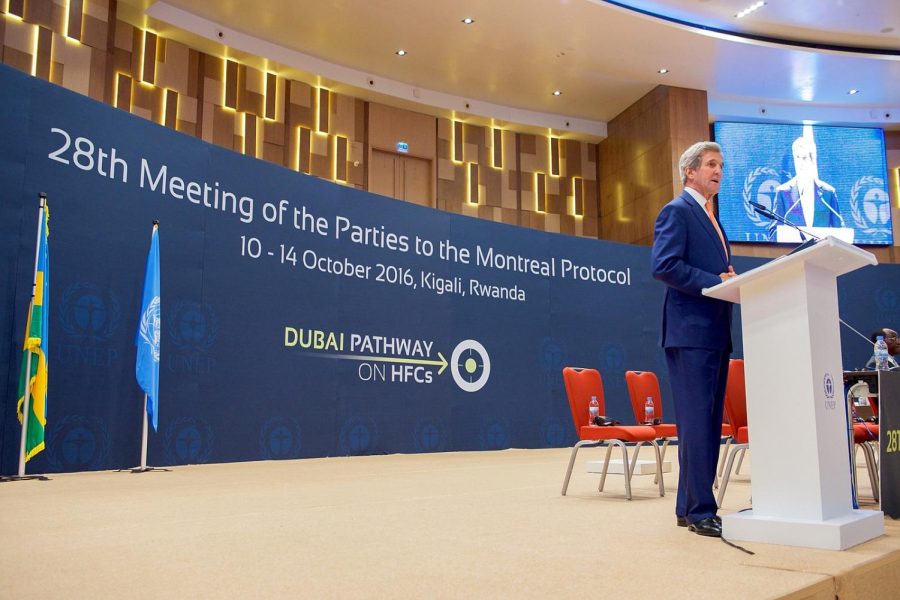Earth’s ozone layer is now 50% healed
September 25, 2022
After 34 years of the banning of ozone-depleting chemicals, Earth’s ozone layer has healed by 50%. This is a victory for scientists and climate activists around the world who have been fighting for action against climate change and its effects on the planet.
To illustrate, the ozone layer is like a protective covering around the Earth that shields it from the Sun’s ultraviolet radiation. Without a proper ozone layer, humans and other organisms are susceptible to overexposure to UV radiation.
This can lead to a myriad of harmful effects such as “severe burns and cancers” according to Steve Montzka, an atmospheric chemist affiliated with the National Oceanic and Atmospheric Administration. Furthermore, UV radiation can affect Earth’s ecosystems, leading to significant habitat and biodiversity loss.
In the 1980s, to combat the ozone layer’s depletion, world leaders cooperated to ban the production of ozone-depleting chemicals, namely chlorofluorocarbons and hydrochlorofluorocarbons. Specifically, in 1987, world leaders signed the Montreal Protocol an international treaty the U.S. Senate unanimously agreed upon in 1988.
This agreement arose after numerous studies reported that CFCs, which are found in household items such as refrigerators, were significantly contributing to the depletion of Earth’s ozone layer and increasing the planet’s exposure to UV light.
With significant evidence to back up the ozone layer’s depletion, the United Sttes. spearheaded an initiative to reduce the production of CFCs and the consumption of ozone-depleting substances. Since then, there has been support from politicians, environmentalists and other officials to take a stance against climate issues.
However, the fight is far from over.
Despite the ozone layer having shown a significant recovery, there is still much to be done to completely restore it. According to Meg Suki, the Executive Secretary of the Ozone Secretariat under the United Nations Environment Programme, “People tend to assume that the ozone hole is history, that we’ve done our job. Actually, we have a lot of challenges still ahead of us.”
There are many obstacles that scientists and politicians face when dealing with the ozone layer’s recovery. These issues ranged from the diversity of Earth’s atmosphere to the slow pace at which the layer is healing. Above all, however, is the comorbidity presented by the planet’s current issue with climate change.
According to the United Kingdom Air Department for Environment, Food, and Rural Affairs, due to its absorption of UV radiation the Earth has been effectively heating up. However, this is not as significant as the effect of carbon dioxide on climate change.
Conversely, climate change impacts the ozone layer because the layer is prone to meteorological changes and climate change directly affects Earth’s atmosphere. Therefore, climate change and ozone-depletion may be related to some degree.
Since the Montreal Protocol, many more actions have been taken to rehabilitate the ozone layer and prevent it from being destroyed.
Namely, in 2016, the signers of the Montreal Protocol instated the Kigali Amendment to reduce the production and consumption of hydrofluorocarbons, which were substituted for CFCs and HCFCs for their lack of impact on the ozone layer’s depletion. However, this came with a trade-off: HFCs are significant contributors to global warming. Thus, the Kigali Amendment was implemented with the goal of reducing the consumption of HFCs by 80% by 2047.
Another example of the global effort towards rebuilding the ozone layer is the individual efforts taken by countries. For instance, after the release of a study by the Natural Resources Defense Council, Inc. detailing how India could combat HFC consumption, the country has begun to change their consumption rates.
Moreover, in the United States, the Environmental Protection Agency passed regulations on the production and import of HFCs.
While it may be decades until the ozone layer returns to its original state, the world is engaging in some preventive measures to ensure that this goal is reached in a timely manner. Many have experienced the firsthand effects of the ozone layer’s depletion, which is further motivation to take action to save the planet.
Individuals may not be able to significantly impact the ozone layer, but a combined effort can surely help to restore the atmospheric shield.







